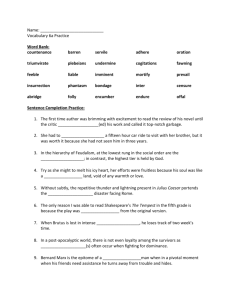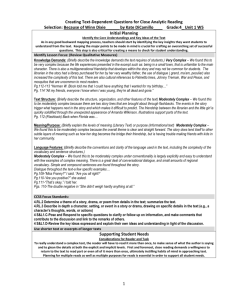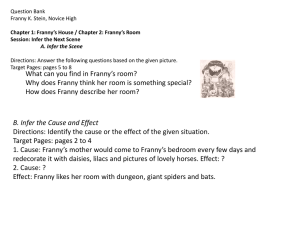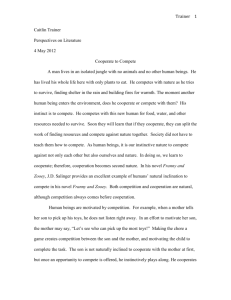Student 1: Student 2:
advertisement
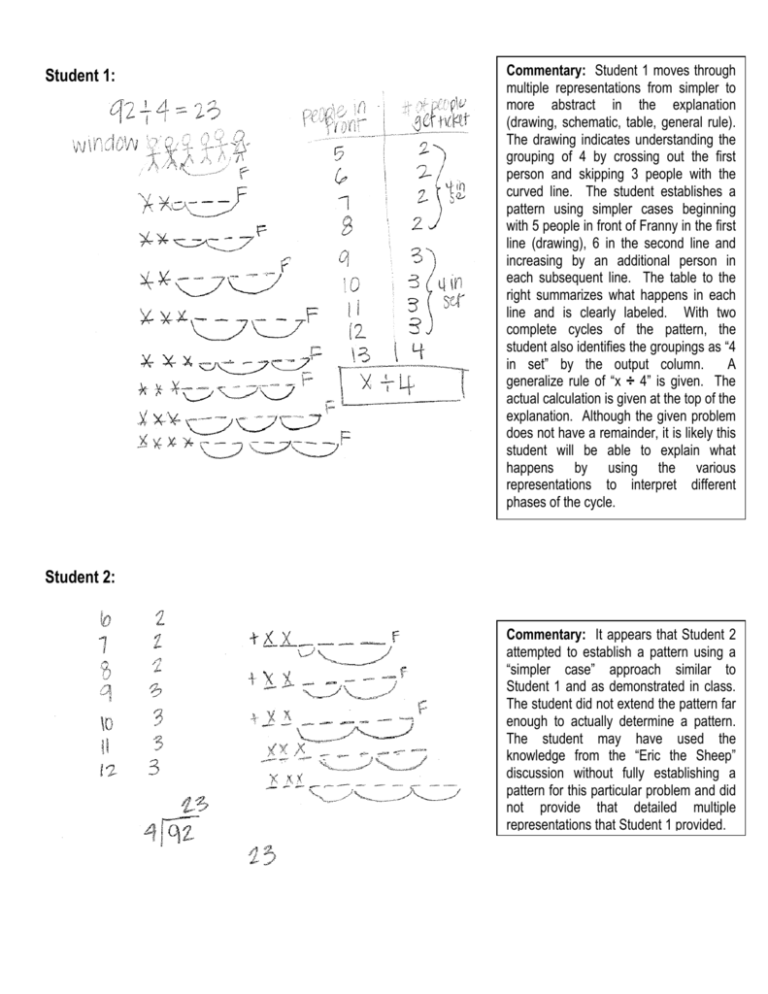
Student 1: Commentary: Student 1 moves through multiple representations from simpler to more abstract in the explanation (drawing, schematic, table, general rule). The drawing indicates understanding the grouping of 4 by crossing out the first person and skipping 3 people with the curved line. The student establishes a pattern using simpler cases beginning with 5 people in front of Franny in the first line (drawing), 6 in the second line and increasing by an additional person in each subsequent line. The table to the right summarizes what happens in each line and is clearly labeled. With two complete cycles of the pattern, the student also identifies the groupings as “4 in set” by the output column. A generalize rule of “x ÷ 4” is given. The actual calculation is given at the top of the explanation. Although the given problem does not have a remainder, it is likely this student will be able to explain what happens by using the various representations to interpret different phases of the cycle. Student 2: Commentary: It appears that Student 2 attempted to establish a pattern using a “simpler case” approach similar to Student 1 and as demonstrated in class. The student did not extend the pattern far enough to actually determine a pattern. The student may have used the knowledge from the “Eric the Sheep” discussion without fully establishing a pattern for this particular problem and did not provide that detailed multiple representations that Student 1 provided. Student 3: Student 4: Commentary: Student 3 drew 92 “x’s” representing the people in front of Franny. Then, she crossed out 1 representing the person who bought a ticket while showing the skipping of 3 people with a curved line. Her marks are a little confusing, but she gives an answer of 23 people with a number of 24 on the right and a division problem showing division of 93 by 4. Commentary: Student 4 “writes” an explanation of Franny’s situation explaining the reason for dividing by “4” which was used in the previous 2 solutions, but not explained. However, because the given problem has 92 people in front of Franny and 92 is divisible a whole number of times by 4, it is not sure how this student would have handled the problem if there had been “people” left over. Student 5: Commentary: Student 5, like student 4, correctly explains the grouping of 4. However, the student then incorrectly includes Franny in the dividend (93). That error creates a remainder. The student then does correctly handle the resulting solution relative to this type of problem and rounds to the next integer value for the answer. It is not clear whether the student actually understands why the rounding is done since no explanation is given. *More fundamentally, this solution indicates that Student 5 does not clearly understand division. The process is incorrectly stated as “4 divided by 93” and the remainder is incorrectly expressed in decimal form. Note that Student 5 provides more insight for Student 3’s division process and use of 93 as the dividend. *A common error of students is thinking that the remainder represents "part" of a person. They then round under the assumption that Franny must pass a "whole" person. Instead, a reminder of 1 in this problem represents the next person who will purchase a ticket prior to Franny's purchase. Consequently, the number of people purchasing tickets prior to Franny is increased by 1. Student 6: Commentary: Student 6 seems to have grasped the mechanics of the process but not an understanding of why it is done. She knows to divide by 4 but incorrectly identifies the composition of the grouping, considering Franny the 4th member of a group as opposed to including the person that buys the ticket.

